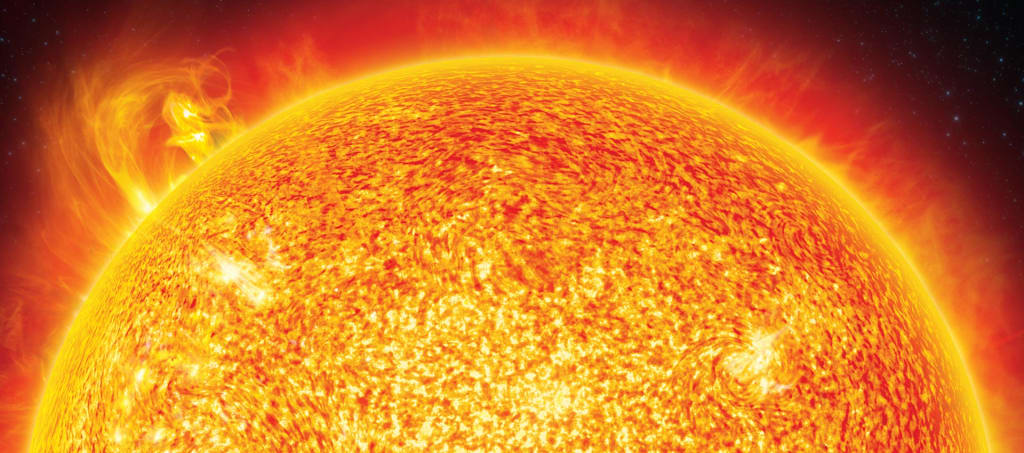
The Sun is the star at the point of convergence of the Planetary gathering. It is a practically ideal heap of hot plasma, warmed to gleam by nuclear blend reactions in its middle. The Sun exudes this energy basically as light, brilliant, and infrared radiation, and is the principal wellspring of energy for life in the world.
The Sun's range is around 695,000 kilometers (432,000 miles), or on different occasions that of Earth. Its mass is on various occasions that of Earth, containing around 99.86% of irrefutably the mass of the Close by planet bunch. Around 3/4 of the Sun's mass contains hydrogen (~73%); the rest is by and large helium (~25%), with much more unobtrusive measures of heavier parts, including oxygen, carbon, neon, and iron.
The Sun is a G-type essential progression star (G2V), nonchalantly called a yellow small individual, but its light is truly white. It molded generally 4.6 quite a while ago from the gravitational breakdown of issue inside a district of an enormous sub-nuclear cloud. A huge piece of this matter collected in the center, while the rest fixed into an orbiting plate that moved toward the Planetary gathering. The central mass ended up being so hot and thick that it in the end began nuclear blend in its middle. Thought for all intents and purposes all-stars structure by this cycle.
Reliably, the Sun's middle breakers around 600 million tons of hydrogen into helium, and in the process changes north of 4 million tons of issue into energy. This energy, which can require some place in the scope of 10,000 and 170,000 years to move away from the middle, is the wellspring of the Light and force. Right when hydrogen blend in its middle has decreased blunt at which the Sun is at this point not in hydrostatic equilibrium, its middle will go through a certain extension in thickness and temperature while its outer layers develop, at last changing the Sun into a red beast. It is resolved that the Sun will end up being satisfactorily gigantic to overpower the continuous circles of Mercury and Venus, and render Earth horrifying in five billion years. After this, it will shed its outer layers and transformed into a thick sort of cooling star known as a white smaller person, and at absolutely no point in the future produce energy by mix, yet sparkle and transmit force from its past mix.
The colossal effect of the Sun on Earth has been seen since old times. The Sun was viewed as by specific social orders a divine nature. The synodic turn of Earth and its circle around the Sun are the reason of a couple of sun situated plans. The overwhelming timetable being utilized today is the Gregorian timetable which relies upon the standard sixteenth century comprehension of the Sun's seen advancement as genuine turn of events.
How warm is the Sun?
The middle is the hottest piece of the Sun, at 15 million degrees Celsius. This is adequately hot to help atomic mix, when hydrogen atoms are merged to shape greater helium particles. These conveyances an extraordinary proportion of energy which subsequently is conveyed as power and light.
The energy made at the middle expects as long as a million years to show up at the outer layer known as the convective zone. At this moment the temperature diminishes to around 2,000,000 degrees Celsius. At the point when it gets to the surface the temperature is down to significantly cooler 5,973°C - yet it is at this point adequately hot to bubble precious stones.
In the Sun's air, known as the crown, the temperature begins to rise again to around 2,000,000 degrees Celsius. As distance from the focal point of the Sun grows greater, the temperature would should drop. This thrilling extension in temperature in the air is one of the star's most prominent mysteries.
The Sun in different tones seen at different brilliant frequencies
The Sun at different splendid frequencies, (l-r) the splendid spots are 60 000-80 000ºC, 1 million, 1.5 million and 2 million degrees
What does the Sun comprise of?
The Sun is a piece of gas and plasma - around 91% of it is hydrogen gas. Under serious force and gravitational power this is entwined into helium during nuclear mix.
Right when the plasma is warmed to the temperatures seen on the Sun, it contains such an abundance of energy that the charged particles can move away from the star's gravity and triumph into space. This is called sun fueled breeze - under unambiguous conditions, when it hits Earth's air it can cause auroras, similar to Aurora Borealis.
Despite hydrogen and helium, specialists have perceived beyond question 65 unique parts in the Sun. The most copious of these consolidate oxygen, carbon, nitrogen, silicon, magnesium, neon, iron, and sulfur.
Does the Sun turn?
To be sure. Regardless of the way that the Sun serious areas of strength for isn't Earth, it really has a turn as the plasma spins around its surface. Overall, it requires 27 Earth days for the Sun to turn once on its center point, yet different parts move at different rates. The focal areas require just 24 days to turn and the polar locale more than 30.
What are sunspots?
Sunspots are cooler bits of the Sun's surface, and occur in the photosphere. The fleeting splurges across the surface appear to be darker to us than the more sizzling plasma incorporating it.
These cooler spots can be all around as much as 50,000 kilometers across. They are accepted to be achieved by coordinated efforts with particularly astonishing regions of the essential alluring field, which barely decline the radiation coming up from the middle, cooling the surface.
A yellow Sun with dull sunspots
Sunspots are cooler regions of the Sun's surface
What is sun fueled flares?
Sun situated flares are the greatest tricky events in the entire planetary gathering. They happen when the alluring fields related with the sunspots convert energy into intensity and accelerating particles, shooting it into space.
They are depicted by a blast of photons - or light - at basically every recurrence. Analysts normally measure the splendid shafts, X-bars and gamma-radiates coming from the daylight-based flares. These conventionally show up as impressive flashes on the external layer of the Sun, and can persevere from just a few minutes to several hours.
What sort of star is the Sun?
The Sun is at this point a yellow smaller person. Like all stars, it began as a contracting cloud - effectively a residue tempest and gas.
As each particle has its own little gravitational power, the buildup and gas began to blend into a protestor. As this mass is organized and collapses in on itself it makes heat. Expecting it ends up being enormous adequate it will eventually get enough hot to consolidate hydrogen into helium. This was the manner in which the Sun outlined.
The heavenly article then, enters its essential gathering stage, during which the outward kind of nuclear blend is changed by the inward pressure of the stars own gravity. The Sun is at this point in this consistent stage.
Sun based flares catapulting out of the Sun
A sun-based flare as tracked down in high energy X-radiates
When will the Sun explode?
It will not. Exactly when the hydrogen in its everything place is burst into flames, it leaves the principal progression stage.
As a by and large little star, the outside layers of the Sun will collapse in on themselves, making temperatures adequately warm to join helium into carbon. At this point the pressure will make the star rapidly become outward to shape a red goliath.
For the Sun, this should occur in around five billion years. It is presumably going to submerge Mercury and Venus - and potentially even the Earth.
It will at last specialist to move toward a planetary cloud with a white dwarf at its middle.
Where might the Sun in the Smooth Way at any point be?
There are a normal 100 billion enormous frameworks in the known universe. The Sun and its eight planets, including Earth, abide in one known as the Smooth Way. Our framework is around one quintillion kilometers across, or 100,000 light years.
The Sun is in a curving arm of the Smooth Way called the Orion Push. This branches off from the world's Sagittarius arm. The Sun and our close by planet bunch are circumnavigating around the point of convergence of the Smooth Way at a speed of 720,000 kilometers every hour. It requires 230 million years to make one complete circle.
What is a daylight based dark?
A portion of the time the Moon isolates the Sun and Earth. If all of the three are changed, the Moon can block the Sun thoroughly, creating a few second thoughts about Earth and causing a sun based dark. This is because notwithstanding the way that the Sun is on different occasions greater than the Moon, the Moon is on numerous occasions closer to Earth.
Sun based covers happen commonly as expected, yet outright sun-controlled covers, in which the Sun is completely blurred by the Moon, are significantly more remarkable. They will for the most part occur around predictably, though much of the time in faraway area of the Earth. These full-scale obscurations can continue onward for as little as several minutes, but never longer than seven minutes.
How might we focus on the Sun?
In view of its preposterous temperatures focusing on the Sun with rockets is irrefutably problematic. We want to rely upon insights using telescopes and cameras on Earth satellites.
Regardless, in 2020 the European Space Association and NASA shipped off the Sun situated Orbiter, which will enter a round circle of the Sun allowing surprising discernments.
Directly following requiring three and a half years to show up at the Sun, it will begin a drawn-out mission to focus on the stars sun-based breeze, appealing fields, and plasma. It will circle as close as 42 million kilometers from the Sun's surface, closer even than Mercury.
About the Creator
Enjoyed the story? Support the Creator.
Subscribe for free to receive all their stories in your feed. You could also pledge your support or give them a one-off tip, letting them know you appreciate their work.





Comments
There are no comments for this story
Be the first to respond and start the conversation.